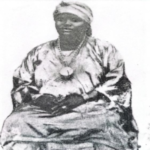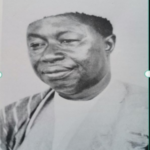
DR. JAMES EMMAN KWEGYIR AGGREY
Dr. James Emman Kwegyir Aggrey (October 18th, 1875-July 30, 1927) was a pioneer of higher education for Africans who was an inspiration for his contemporaries, and who promoted mutual respect between black and white communities in Africa and United States. His wise sayings are still quoted as proverbs on Ghana.
Aggrey was born at Anomabu eight kilometers east of Cape Coast. He was the 17th child of Kodwo Kwegyir by his third wife, Abena Andua. His father was a gold-taker (assayer) who worked for a time for John Sarbah (q.v.), an African merchant of Cape Coast whose son, J. Mensah Sarbah (q.v.), was to become the famous nationalist lawyer. Kodjo Kwegyir was also a linguist (spokesman) to the chief of Anomabu. Aggrey’s parents were illiterates. He was eight years old when his parents became Christians, he was then sent to Cape Coast Methodist School. At the age of 13 he together with some other young boys were selected to live at the Cape Coast Mission house as part of the Missionary family. At the age of 15 he was appointed as teacher in charge of a small school in Abura. Dunkwa about 20mi (32km) from Cape Coast. A year later he returned to his old school as assistant teacher. In 1895, he received top honors in the teacher’s certificate examination and was awarded a prize by the Gold Coast Legislative Council.
In 1895-1896, a British expeditionary force was sent to Kumasi to receive submission of the Asantehene, Prempeh I (q.v.), and Aggrey as was the practice for the time volunteered for military service. He served as an interpreter in the Telegraph Corps. Upon his return to Cape Coast, he became the headmaster of the Methodist School.
During this period, he had so many part time activities. He was the assistant translator of the Fante bible, an amateur printer, and an interpreter, and he also participated in the works of the Aborigines’ Rights Protection Society (A.R.P.S), founded in 1897. He became the society’s recording secretary, and contributed to its successful campaign for withdrawing of the Lands Bill of 1897, which aimed at making crown lands such lands as were not in visible use. He was also the sub-editor (copy editor) of the Gold Coast Methodist Times and which its columns to attack the bill.
In July 1898, Aggrey sailed for the United States after being granted a scholarship by Bishop John Bryan Small (a West Indian) of the African Methodist Episcopal Zion Church (A.M.E.Z) in New York. The scholarship was to enable him qualify as a minister of religion in order to return to work for the Church in the Gold Coast. In October, he entered Livingstone College in Salisbury, North California where he took his bachelor’s degree graduating at the top of his class in 1902, and winning a gold medal. Bishop Small had expected Aggrey home to work in the Gold Coast but he refused to hon or his obligations and remained at Livingstone where he became a registrar and a financial secretary, subsequently joining the teaching staff. In 1903, he was ordained as an elder in the A.M.E.Z. Church with which the college was affiliated. On November 8, 1905, he married a black American, Rosebud Rudolph Douglass of Portsmouth, Virginia. He studied at Hood Theological Seminary in Charlotte, North California which awarded him a doctorate in Divinity in 1912. During this period, he also worked part time in the publishing house of the Zion Church in Charlotte and contributed occasional articles to the Charlotte Observer. His influence at Livingstone was such that when the presidency of the college became vacant in 1917 he was suggested for the position but was disqualified at that time on grounds of his nationality. When the position again became vacant in 1924, it was finally offered to him but he declined because he had decided to return to work in Africa.
While teaching at Livingstone, Aggrey took vacation courses at Columbia University in New York, aiming for one of its prestigious degrees which was then a near monopoly of whites. In December 1923, he was to pass his doctoral examinations at Columbia and had only to complete his thesis.
Meanwhile, through the influence of Dr. Jesse Jones, the Welsh chairman of the commission established by the Phelps-Stokes Fund in New York to enquire into Education in Africa. Aggrey was appointed as the only African member of the commission. To begin with, the commission decided to study conditions in West, South and Equatorial Africa. Aggrey left New York in July 1920 for the United Kingdom where he met several influential people in London who were in interested in African education including Sir Gordon Guggisberg (q.v.), governor of the Gold Coast (1919-27). The commission’s first visit was to Freetown, Sierra Leone where it begun, its work and where Aggrey made a favorable impression on the students at Fourah Bay College. Visit were then paid to Liberia and to the Gold Coast, Aggrey met with Guggisberg and the two men became friends. Upon landing in Sekondi, in what is now South Western Ghana, Aggrey experienced the color bar by being refused accommodation in the government rest house where the white members of the commission were lodged. But his home-coming was otherwise a grand one, the reception he received in the Gold Coast made him decide to return again to Africa in the future.
The commission’s work then took Aggrey to Nigeria, the Belgian Congo, Portuguese Angola and South Africa. He saw and appreciated the racial problems in these countries and was able to make contributions seeking to demonstrate especially in South Africa that with Christian Charity it was possible for different races—Africans l, whites Indians, Coloreds to live amicably together. Whiles in was in South Africa, the native college of Fort Hare( today the University College of Fort Hare), near Grahamstown in Cape Province offered him the professorship of sociology but he declined.
After the publication of the report of the Phelps-Stokes commission in 1922, the British government established a Central Advocacy Committee on Education in Tropical Africa and began to plan educational programs for the British African Colonies. In the same year, Aggrey obtained his master’s degree in from Columbia as well as his teacher’s diploma. He was appointed in 1923 to the second Phelps-Stokes Commission, which was to study educational conditions in East Africa. After visiting Ethiopia, where those that he met wished him to return to work in the educational system there. Aggrey, with other members of the commission visited Kenya, Uganda, Tanganyika, Nyasaland and the Northern and Southern Rhodesia. In some of these countries Aggrey has to endure the indignities of racial discrimination from the white settlers. He revisited South Africa, where he made profound impression on the students at Stellenbosch University, the Afrikaans Institution in Cape Province, and on the white teachers’ association of Cape Province in Cape Town.
Aggrey has by then return to the Gold Coast to help establish Achimota College near Accra- a decision that he took as a result of meeting with the first principal, Rev. A. G Fraser (q.v) in London in January, 1924. Fraser offered him the vice-principalship of Achimota and in March Aggrey accepted. He resigned his post at Livingstone and made provision for his family- he now had 3 children, Abena Andua (born 1907) Kwegir (1908) and Rosebud (1910) and left for the Gold Coast. He arrived in Accra on October 15, 1924. When his appointment was however gazettes it was assistant Vice Principal rather as vice principal. He took this rebuff in good part since he knew that it was British colonial policy not to have an African act as principal in the absence of the white incumbent.
In Gold Coast, Aggrey preached cooperation between the black and white races. His saying that” You can play a tune of sorts on the white piano keys, and you can play a tune of sorts on the black keys, but for harmony you must use both the black and the white”, became famous. His symbol of the black and white piano keys was adopted as the Achimota College emblem. The African politicians were however suspicious of the British government’s intention in founding Achimota and Aggrey has to travel extensively to explain the idea of Achimota to his educated country men. He succeeded in allaying their fears and by January 1927 when the buildings were ready and the students had moved in, Achimota had been accepted as the symbol of educational progress in the country by leading African Nationalists such as J. E. Casely Hayford (q.v)
Between 1924 and 1927, Aggrey tried to put into practice his theory that hard work was needed with the hand as well as the head, and Achimota began by laying emphasis on social service, agriculture and the African traditional heritage.
After Achimota was formally opened on January 18, 1927, Aggrey obtained leave of absence to return to the United States to complete his Columbia doctoral thesis which was on the subject of British relations with Africa. He left in May and went back to England to work on the thesis. He returned to the United States in1926. His last child, Rudolph had been born in his absence and was going to be christened. Aggrey could not stay for the christening but left for the New York where he suddenly fell ill and died of pneumococcus meningitis in Harlem hospital on July 30.
His death was deeply mourned in the Gold Coast and among his friends and acquaintances in Africa. Europe and United States. His name has since become a legend in his own country. Although he wrote no book, he left behind sayings which are often quoted. Achimota has an Aggrey house and an Aggrey Memorial Chapel both named after him. At the time of independence, the Ghana government established the Aggrey-Fraser Guggisberg Memorial Lectures to be delivered annually in honor of the men whose vision made university education in the county a reality.


